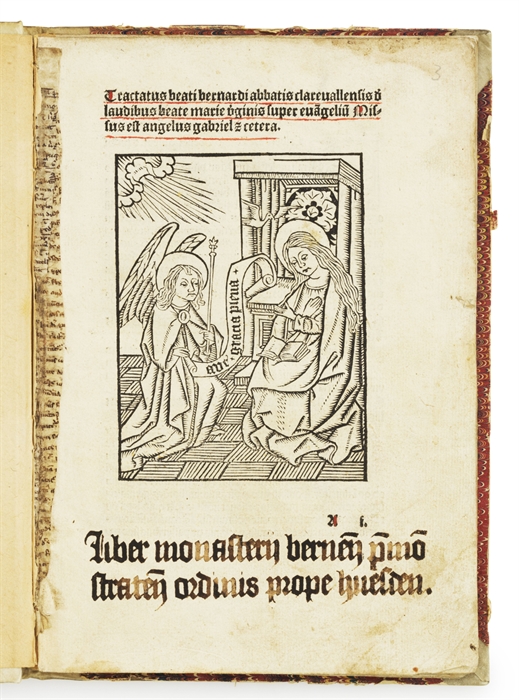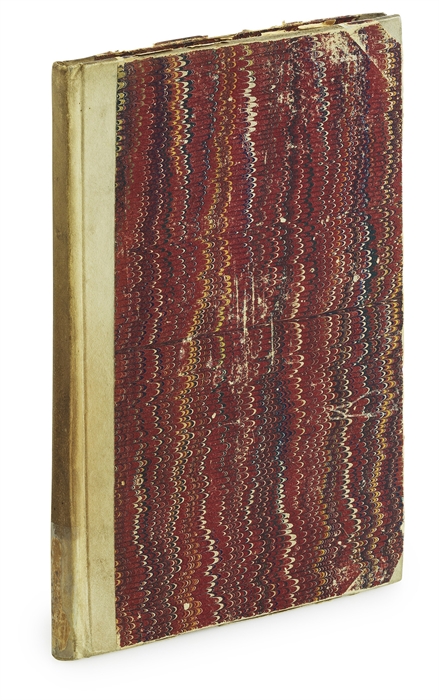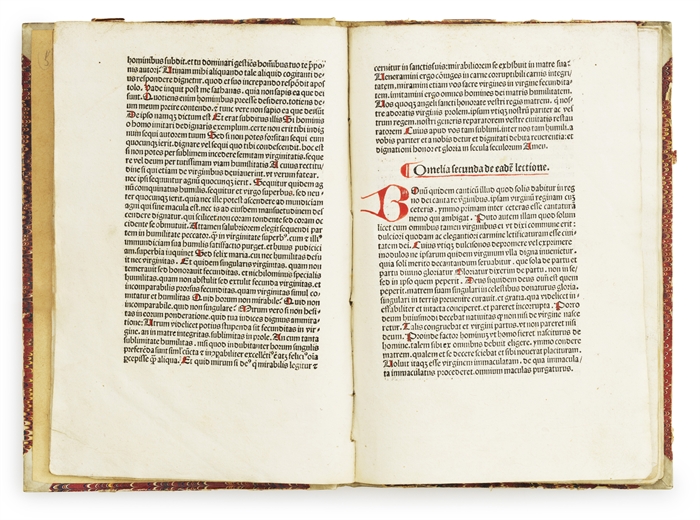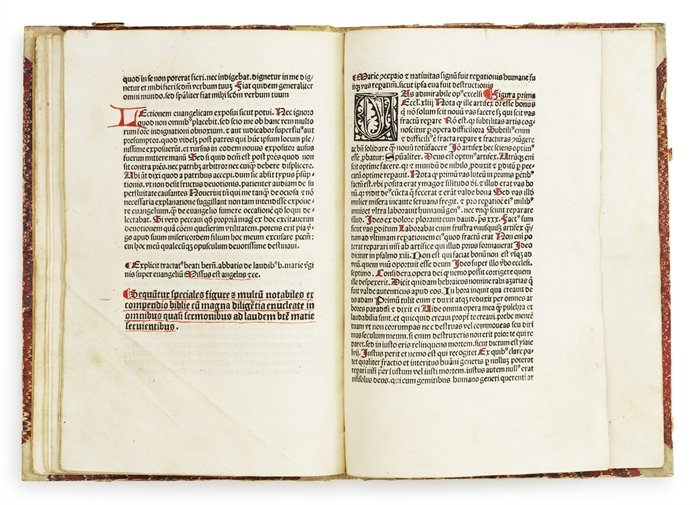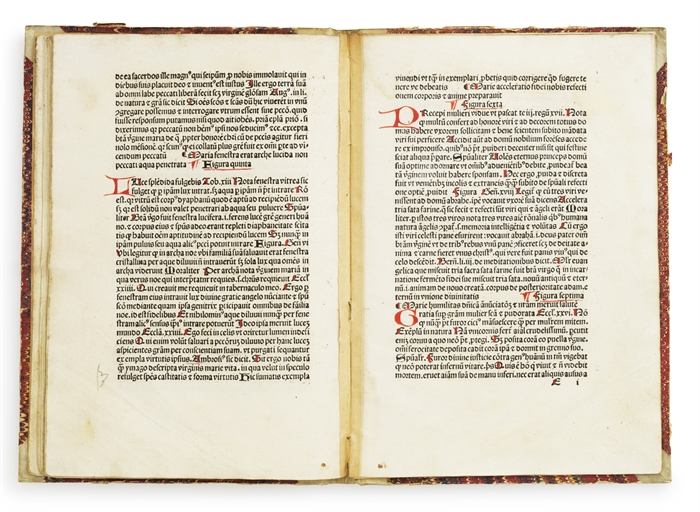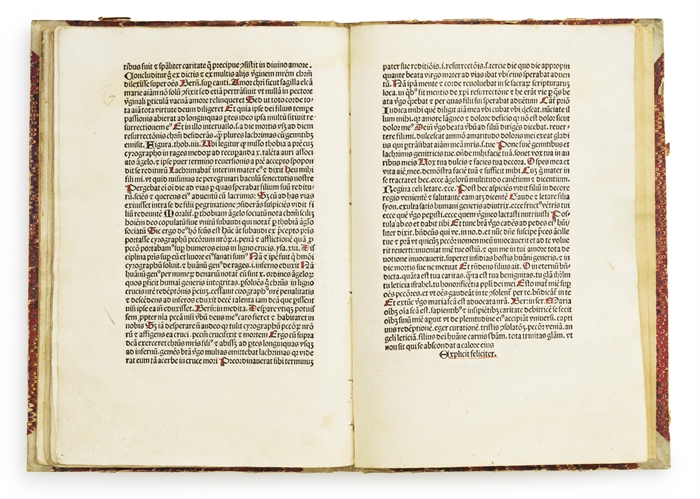SHAPING MARIAN DEVOTION - THE SCHÄFER-COPY
BERNARDUS CLARAEVALLENSIS - BERNARD OF CLAIRVAUX - SAINT BERNARD -
Tractatus beati bernardi abbatis clareuallensis d laudibus beate marie vginis super euageliu Missus est angelus gabriel cetera.
(Antwerp, Gerard Leeu, undated but between August 2, 1487 & 1489)
4to (204 x 141 mm). In 19th-century half vellum over marbled paper covered boards. Old paper-label stating "Bernadus" pasted on to lower part of spine. Light wear to extremities, spine slightly discoloured and boards with a few scratches. First 6 ff. reinforced by fragments of a 13th-century manuscript on vellum. Ex-libris pasted on to back free end-paper. Title woodcut illustration depicting the Annunciation (belongs to a quarto series of 68 blocks by the "Second Gouda Woodcutter", specifically to the 44 blocks copied from Israhel van Meckenem’s smallest Passion series. The present impression is the sixth - see Bibliothek Otto Schäfer, vol. 1, p. 165). Title-page slightly soiled. Lower margin of title-page with annotation in contemporary calligraphed hand "Liber monasterij bemensis premonstratensium ordinis huesden" (see below). Lower blank margins throughout carefully washed and pressed. Housed in a green slipcase. 30 ff.
Provenance:
- The Abbey of the Prémontrés of Berne (near Heusden, Netherlands); contemporary manuscript inscription: "Liber monasterij bemensis premonstratensium ordinis huesden". (15th/16th century).
- Portsmouth/Bishophouse (United Kingdom), Virtue & Cahill Library (Christie’s 5-7-1967.) Nr. 8, bought by Breslauer.
- 1968: Sold by Breslauer to:
- Otto Schäfer Collection, Schweinfurt (Federal Republic of Germany), with its "OS" stamp.
Exhibited at “Druckgraphik des 15. Jahrhunderts”, organized by Mr. Otto Schäfer in 1973 for the Fränkische Bibliophilen-Gesellschaft, Schweinfurt (N° B.83, described p. 64 of the catalog).
Katalog der Bibliothek Otto Schäfer Schweinfurt, no. 42.
Second - being the first illustrated - edition of Bernard of Clairvaux’s seminal work on the Virgin Mary, her virtues, her role in salvation and her theological significance. It is structured as a commentary on the passage from the Gospel of Luke (1:26) where the angel Gabriel announces the Incarnation to Mary. Bernard was a produtive writer on various aspects of the Bible and Christianity. As a devoted Mariologist, he emphasized Mary's central role in Christian theology and preached effectively on Marian devotions, making the present publication one of the most representative and influential of all his works. It was pivotal in shaping Medieval and Renaissance Marian devotion. Antwerp rapidly emerged as a dominant center for illustrated books in the late 15th century, with Gerard Leeu, the printer of the present work, at the forefront of this movement. He was among the most prolific printers of his time, using over 850 different woodblocks across his works: The present work has a most fascinating provenance. The earliest recorded ownership of this book places it in the Abbey of the Prémontrés of Berne, located near Heusden in the Netherlands. It was most likely placed in this library immediately or shortly after printing, judging from the inscription on the title-page. The Abbey of Prémontré was among the monasteries suppressed after the French Revolution and it was demolished in 1790. BM 15th century IX, p. 193 OCLC only listS one copy in the US (Cambridge MA, Harvard University, Houghton Library)
"Antwerp rapidly became the main centre for illustrated books in the Low Countries and Gerard Leeu was without doubt the most prolific printer of them, with more than 850 different woodblocks used in the books he produced. He collaborated with anonymous engravers, whose names came from their place of activity: from the First and Second Gouda woodcutters, to the Master of Haarlem and the First Antwerp Woodcutter. Leeu also obtained many other engravings from colleagues such as Jacob Bellaert (fl. 1483-1486) from Haarlem, or Heinrich Knoblochtzer (c. 1445-1500) from Strasbourg. As evidence of his good relationships with certain other printers, Leeu did not hesitate to lend them woodblocks, as, for example, he did with Johann Koelhoff (c. 1502) in Cologne and Arend de Keysere († 1489) in Ghent. After his death, his collection of woodblocks was dispersed amongst several printers, such as, in Antwerp, Adriaen van Liesvelt (fl. 1494-1500), Dirk Martens, Roland van den Dorp († c. 1500) and Henrick Eckert, as well as the Zwolle-based Peter Os van Breda (fl. 1480-1510). Leeu is a perfect example of a printer who used all available means to get hold of the materials required to illustrate his editions, and, in contrast to some others, he never resorted to using less competent engravers who would simply copy woodcuts that appeared in the publications of competitors." (Adam, The Emergence of Antwerp as a printing centre, p. 21).
At some point, the book crossed the North Sea and found its way to England. By the mid-20th century, it was housed in Portsmouth, specifically at the Bishophouse, and became part of the Virtue & Cahill Library collection.
The book was later sold at Christie’s auction on July 5–7, 1967 (catalogued as Nr. 8), where it was purchased by Bernard Breslauer.
In 1968, Breslauer sold the book to Otto Schäfer, the noted German collector and industrialist. Schäfer’s collection in Schweinfurt was renowned for its focus on early printed books and illustrated incunabula. During its time in the Schäfer Collection, the book was exhibited in 1973 as part of the “Druckgraphik des 15. Jahrhunderts” exhibition, organized for the Fränkische Bibliophilen-Gesellschaft in Schweinfurt.
Goff B400
Hain-Copinger 2864-2865
Schäfer 42
ISTC: ib00400000
Order-nr.: 62077

